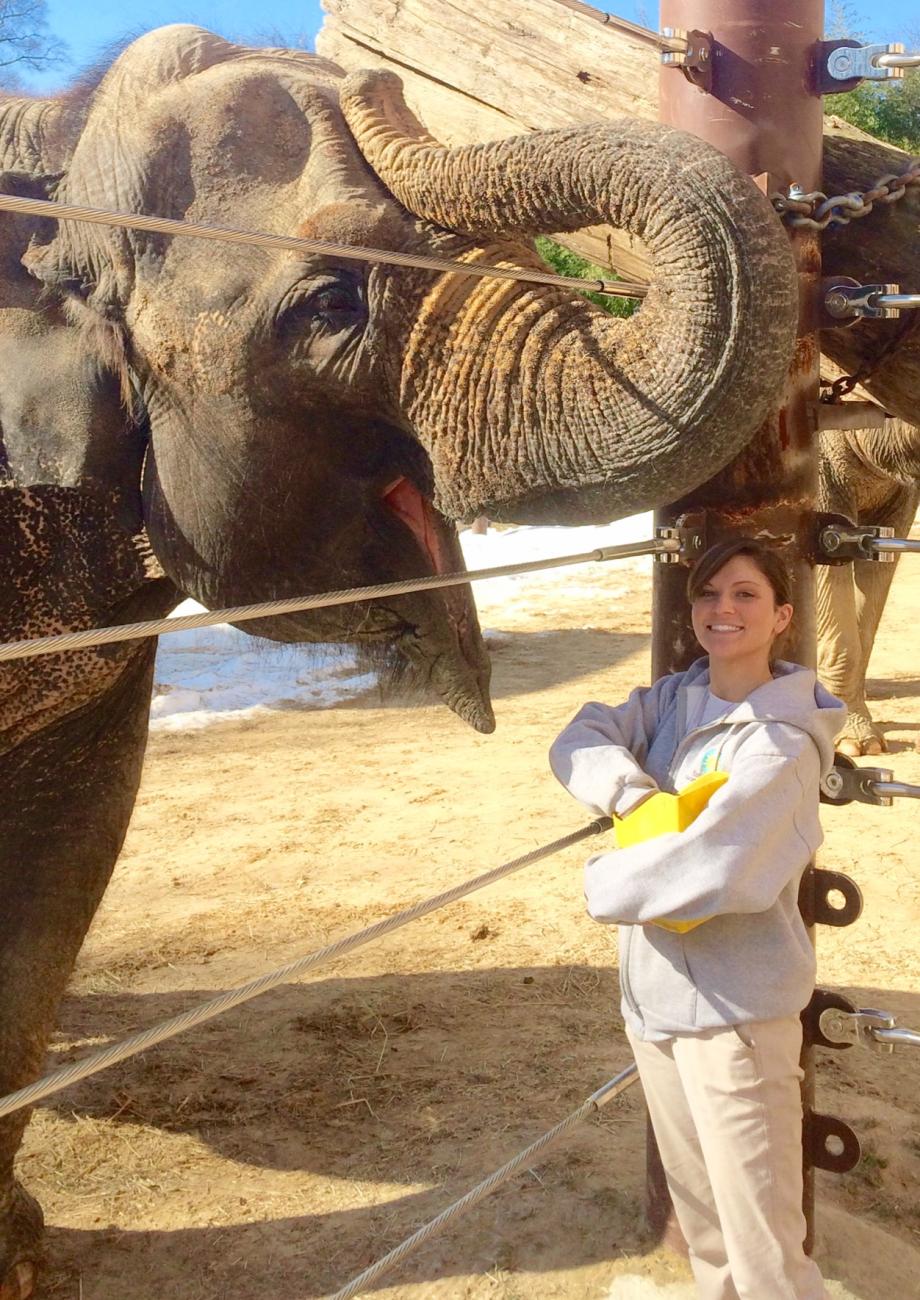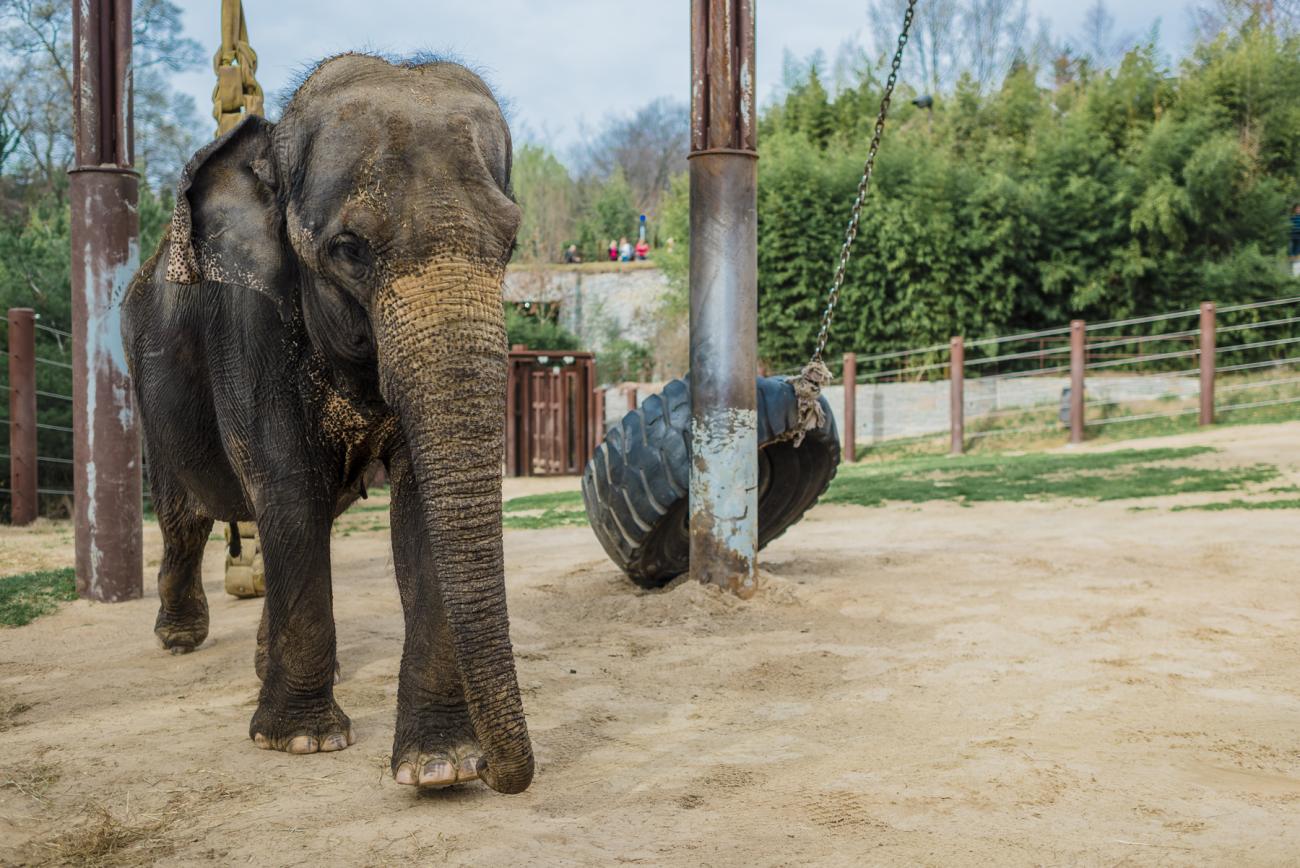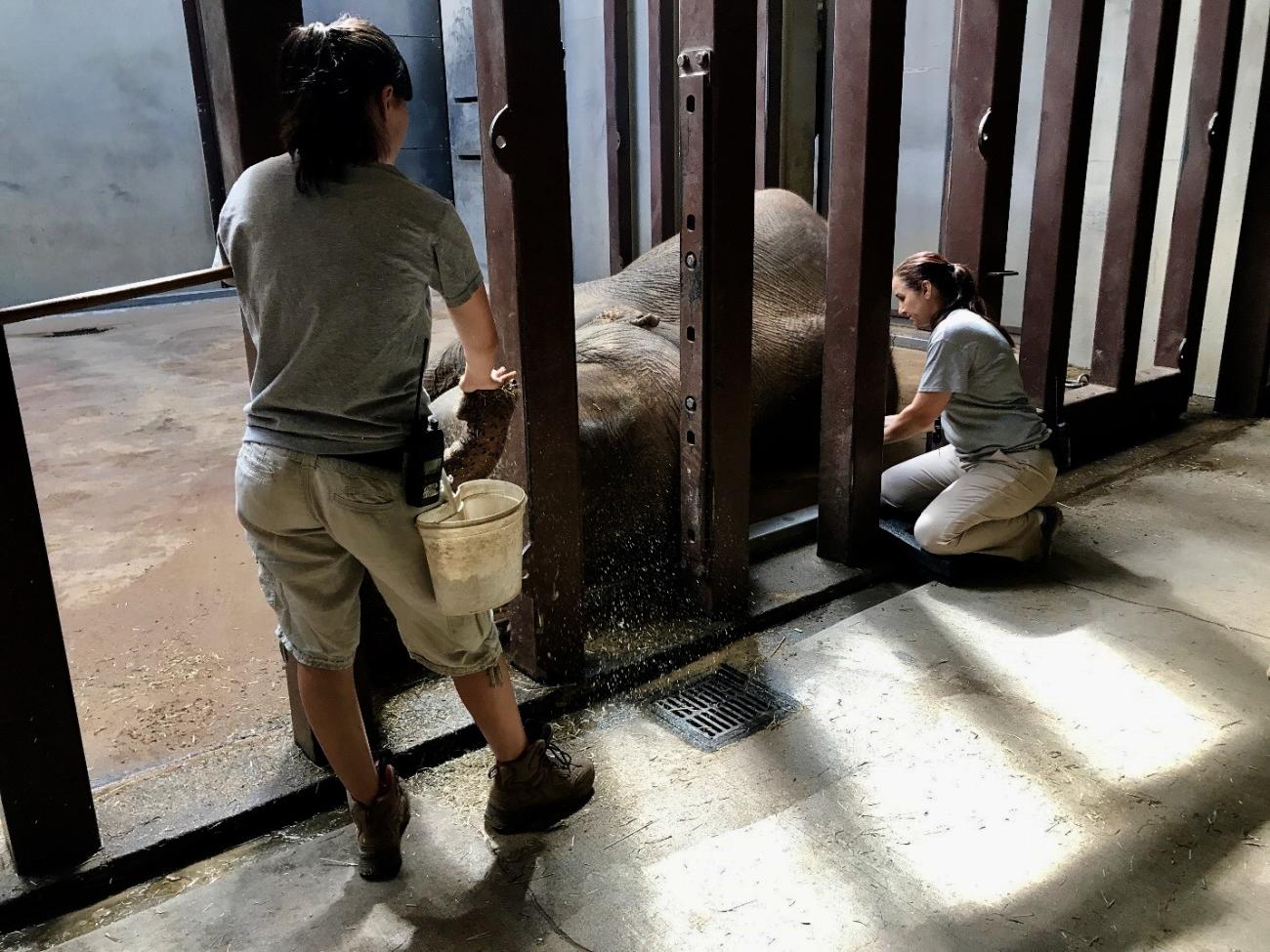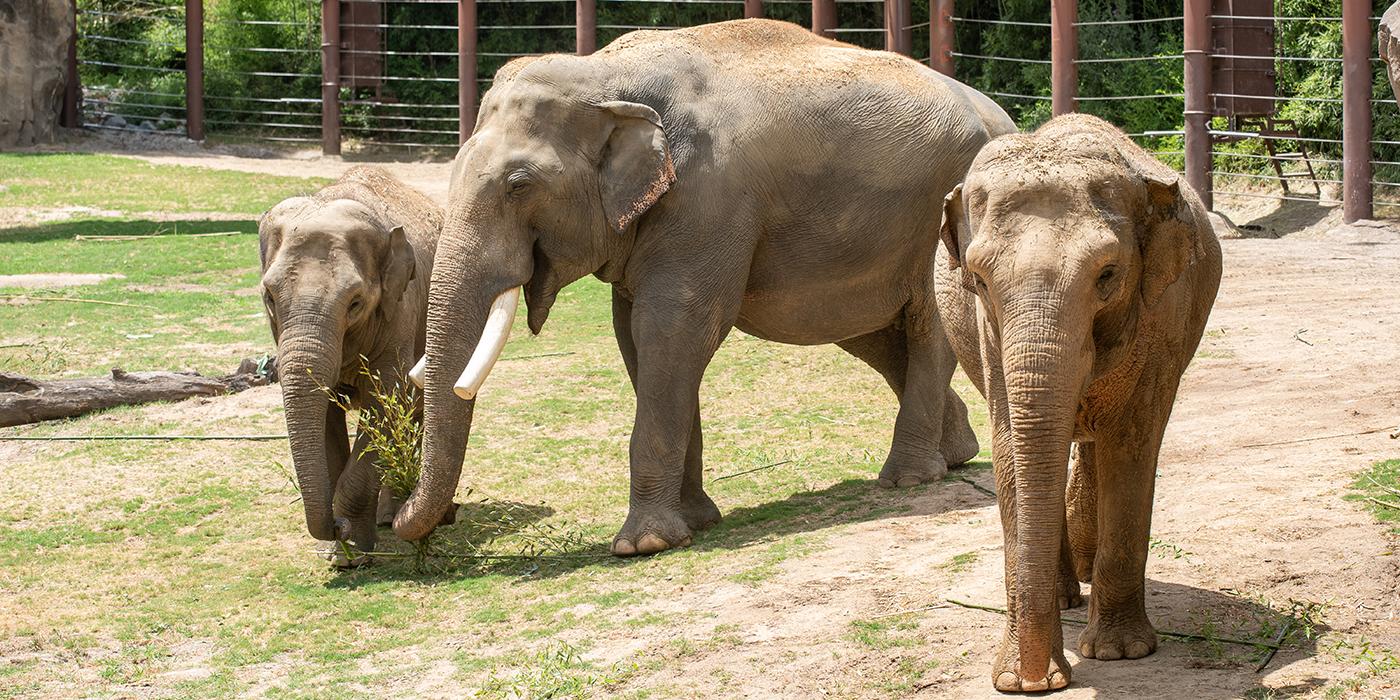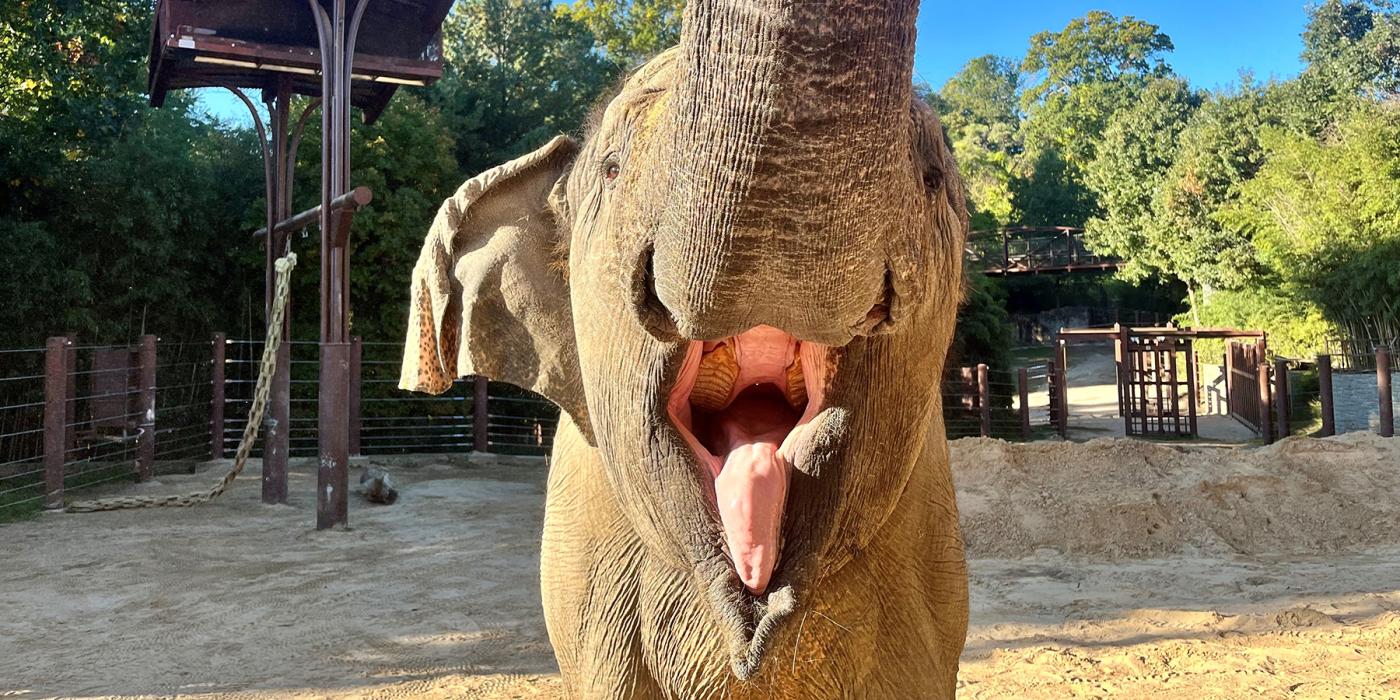Spotlight on Training: Asian elephant Kamala
Ever since 42-year-old Asian elephant Kamala arrived at the Smithsonian’s National Zoo in May 2014, keeper Amanda Bobyack has helped her settle into her habitat. Part of that adjustment included learning husbandry and medical training behaviors that help Bobyack, her fellow keepers and the vet team care for Kamala. In this Q&A, Bobyack describes how working with Kamala has been a fun, challenging and surprising journey.
What do you find so endearing about Kamala’s personality?
Getting to know Kamala, as well as her likes and dislikes, has helped me develop a close relationship with her. Each elephant has a unique personality, but Kamala stands out from the crowd. She seems to enjoy interacting with our keeper team and will go out of her way to capture our attention. She’s takes quite an interest in us and will often sniff our shoes! We’re not sure what it is about the smell of feet that is attractive to her, but she will rumble and squeak which tells us she’s happy and excited to see (and smell) us.
What behaviors are you training Kamala to do?
We use a method called operant conditioning to train our elephants, which means they can choose whether they want to take part in our training sessions. If they do, they are rewarded with a treat and an enthusiastic “good girl!” from their keepers.
We can tell that Kamala enjoys learning new behaviors because she will do them outside of our training sessions. One of the exercise behaviors she does frequently is pick up her right-front foot and back-left foot at the same time, then alternate. She seems to get a kick out of our reactions!
Kamala, more so than any of our other elephants, does not seem to mind needles, which is especially helpful when it comes to blood draw training. Most of the time, we take blood from the elephants’ ears. There are several large veins that are easy to access. As the elephants age, however, it can become harder to find a vein. One of the alternative areas for drawing blood is the rear leg. Because Kamala is missing a notch in her left ear, this training is especially important for her to learn because it will enable us to consistently monitor her hormones and overall health. Likewise, we are training her to station (stand still) for an ultrasound in our transfer chute. This isn’t for a reproductive assessment; rather, we want to be prepared in the event she becomes ill and an ultrasound can help our veterinarians diagnose the issue.
One of Kamala’s health issues that we are currently monitoring is her arthritis. We were able to confirm that she has arthritis in some parts of her ankles as well as her back legs because we trained her to participate in radiographs. Arthritis is a chronic condition and cannot be cured, but we can help to manage and slow the onset by providing a variety of treatments, including anti-inflammatory medications. She recently received a series of Adequan injections, and we have seen the stiffness in her joints significantly decrease ever since. It is possible that the warm weather and the opportunity to swim in the pools has helped as well.
As part of the elephant enrichment program, keepers build dunes made of dirt and sand for the elephants. Elephants often use their trunks to pick up and toss dirt on their backs to protect their skin from the sun, and providing this enrichment encourages them to do this natural behavior. In the video above, Kamala is playing in a sand pile that keepers created inside the barn.
Why is it important to teach Kamala husbandry and medical behaviors?
It is all about giving Kamala a great quality of life. We are fortunate to have the option to try many different treatments that can benefit her in both the short and long-term. Our hope is that, by working with Kamala, we can find the most effective treatment for early onset arthritis in elephants. Not only would that help her but also it has the potential to help other elephants in human care.
What is Kamala’s reward for participating in training?
Unlike Ambika, Shanthi, Bozie, Maharani and Swarna—who are very motivated by food—Kamala seems to enjoy receiving praise and attention from the keepers more than an edible reward. However, we still offer some of her favorite foods when she does a behavior asked of her, including chipped hay, apples, sweet potatoes, watermelon and celery. All of the elephants seem to like foods that have a good crunch to them.
What are the challenges of training Kamala?
In general, elephants are very honest about how they feel. The relationship I have built with Kamala these past three years has helped me to recognize when we can push to learn a new behavior, and when to take a pause. We go at her pace, when she is calm and ready.
Whenever we train a new behavior and move on to the next step, there are bound to be some setbacks. If Kamala decides she does not want to do a behavior, we will start over from the beginning and try again. Although she may not enjoy doing a certain behavior, once she is over the hurdle and receives a big reward for participating, she is more willing to do that behavior in the future. It doesn’t take us long to get back on track.
What was Kamala’s biggest training achievement?
Elephants have an amazing memory, which helps us to build our training repertoire and teach the elephants behaviors that are more complicated. Having a consistent routine is paramount to having a successful training session. Often, they know which behaviors we are going to ask for and are three steps ahead of us!
Kamala had one of those ‘aha’ moments during a recent training session. We had not practiced the blood-draw-while-laying-down behavior in six months. Over the winter and spring, she showed some discomfort from her arthritis; but, once summer arrived, she was up, moving and had a bit more pep in her step overall. Since it was clear that she was feeling better, I introduced this training once again and was surprised that she immediately recognized the cue and put herself in the perfect position for us to draw blood from her ear. It was amazing to me that even after a long break she knew exactly what to do because we kept the same routine.
This story appears in the August 2017 issue of National Zoo News. Enrichment and training allows animals to demonstrate their species-typical behavior, gives them opportunity to exercise control or choice over their environment and enhances their well-being. Learn more about the Zoo’s Animal Enrichment and Training Program.Related Species:


